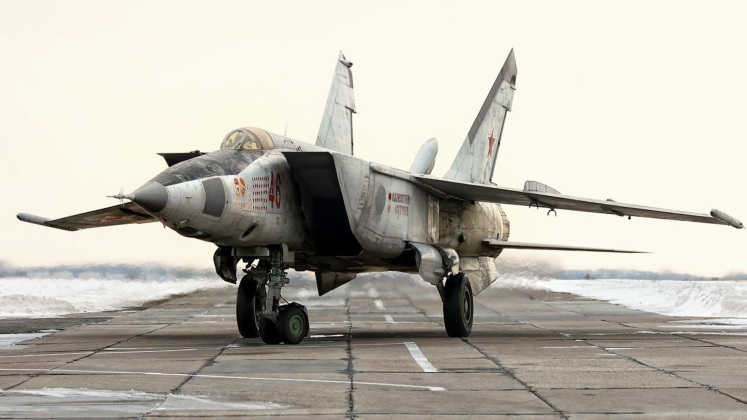In 1982 the first of many air battles between Cold War era heavyweight fighter/interceptors marked the beginning of a new era in tactical combat aviation – an event which had been led up to for two decades by ambitious programs in the United States and Soviet Union. Heavyweights with armed takeoff weights well over 20 tons remain to this day the undisputed leaders in terms of air to air capabilities, and generally boast much longer ranges, larger radars, greater firepower and superior flight performances than their lighter counterparts. At the time only the Soviets and Americans were able to develop heavyweight fighters, with a French attempt under the Mirage 4000 program failing, although they have since been joined by China which emerged in the 2010s as a leader in the field.
The USSR was the first to enter a new league of weight ranges with its MiG-25 Foxbat interceptor, which first flew in 1964 and became operational in 1970 as a high performance third generation interceptor. The aircraft proved all but invulnerable to the most capable Western anti aircraft assets of its time, as demonstrated numerous times in combat. Perhaps the most notable demonstration were Foxbat flights over Israeli held territory in the early 1970s from a Soviet facility in Egypt, which saw the Israeli Air Force equipped with the most capable NATO fighters and air to air missiles – F-4E Phantoms and AIM-7 Sparrows – fail to seriously threaten the aircraft flying deep behind its lines.

The United States responded to intelligence on the MiG-25’s development by making the specifications of the F-15 Eagle fourth generation fighter, then under development, significantly more ambitious. Like the MiG-25 the F-15 was a heavyweight, and although much slower and using much smaller missiles than the Foxbat it was designed to be able to go head to head with it if needed. Despite coming from different generations the F-15 and MiG-25 were in many respects closely matched, with the two engaging one another multiple times in the 1980s and early 1990s with their final engagement over Iraq seeing a MiG neutralise an Eagle for no losses.
While the F-15 was the premier fighter fielded by any Western air force during the Cold War, the more capable F-14 Tomcat was developed for the United States Navy and remained unrivalled particularly in its beyond visual range capabilities. Where the F-15 struggled to tackle MiG-25s, the F-14 was acquired by the Iranian Air Force in the early 1970s specifically because it could more reliably engage the advanced Soviet jets. Although the MiG-25 had a lower status in the Soviet armed forces when the Cold War ended, having been surpassed by fourth generation heavyweights the MiG-31 and Su-27 which were both far more capable in air to air combat, it was analogous to the F-14 in that both were the most capable fighters or interceptors the two superpowers ever exported. The two saw combat multiple times during the Iran-Iraq War, when Iranian F-14s were relied on heavily to engage the Iraqi fighter and bomber fleets and found MiG-25s to be by far their most challenging targets. The two also remain to this day the heaviest fighter/interceptors ever to be exported.

The first engagement between the F-14 and MiG-25 took place on February 15, 1982. The MiG had very strong advantages in its speed and altitude, and carried R-40 missiles with significantly larger 100kg warheads, while the F-14 boasted a more powerful sensor suite, much longer engagement range, and far superior manoeuvrability. The F-14’s AIM-54 missile also had the advantage of active radar guidance – a feature no other fighter’s armament would receive until the 1990s – allowing it to ‘fire and forget’ against enemy aircraft. While the MiG-25 and F-15 were well matched in the air, against the F-14 the MiG was at a significant disadvantage due primarily to the discrepancy in sensors and armaments.
The Iran-Iraq War nevertheless demonstrated that engagements were not entirely one sided, with the first clash ending in a draw. The MiG-25’s R-40 missile hit and damaged the Iranian F-14 it faced, but failed to bring it down, while the F-14’s AIM-54 missile similarly damaged its adversary but not sufficiently to claim a kill. This was hardly the last engagement between the two aircraft, with Iraq reportedly later acquiring the specialist MiG-25BM, an electronic attack variant of the Foxbat with anti radiation missiles, which proved capable of repeatedly evading F-14 attacks to target key infrastructure deep inside Iran. Both the MiG-25 and the F-14 gained multiple kills against other fighter classes, but against one another one Tomcat was lost in air to air combat for the loss of 1-2 MiGs. Struggles against the small and questionably operated Iraqi MiG-25 fleet raised serious questions regarding how Iranian F-14s would have fared against much more capable Soviet MiG-25 units, which was the threat the very costly aircraft were acquired specifically to counter.
The MiG-25 was ultimately phased out of production in 1985, and finally retired from Russian Air Force service in 2013. The F-14 saw a much shorter service life in the United States Navy, retiring in 2006, with a primary drawback of both designs being their extremely high operational costs. The MiG-25 today has been replaced in the Russian fleet by the MiG-31BM/BSM, although a replacement for the electronic attack variant has yet to materialise. The F-14 has no direct analogue in the U.S. Navy today due primarily to budget cuts, with its AIM-54 missile still having a longer range than any other American missile to be introduced. A heavyweight successor to the Tomcat with sixth generation capabilities is currently under development.
